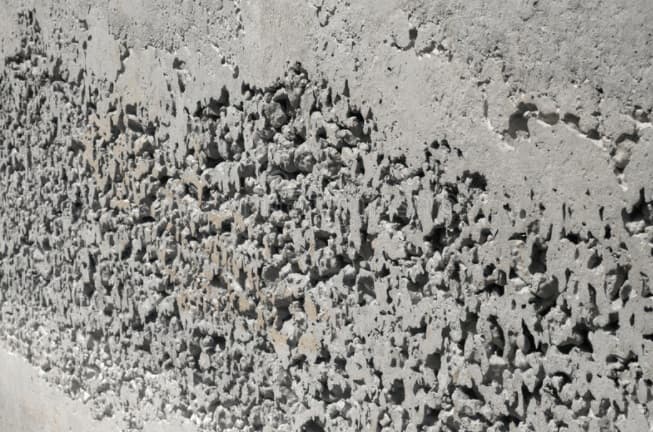
Concrete is relatively a durable material. However, it does suffer damage or undergo distresses during its lifetime due to several reasons. The quality of concrete suffers either during the production or during service conditions because of the varying conditions under which it is produced at various locations which results in distress.
There are number of reasons of concrete getting affected. At times, the externally applied loads can be the structural cause of concrete distress. Sometimes due to error in design, poor detailing and poor construction practices, distresses may arise in the structure. The other reasons of concrete getting affected can be thermal stresses, drying shrinkage, chemical reactions, weathering, and corrosion of reinforcement.
Some of the noticeable defects on the surface of fresh concrete are:
- Bulges
- Ridges
- Rock pockets and honeycombs
- Dimensional Errors
- Finishing Defects
Here we are keeping the scope of the content limited hence; we are particularly going to discuss about “concrete honeycombing” – one of the common defects, in this article.
What is Honeycomb in Concrete?
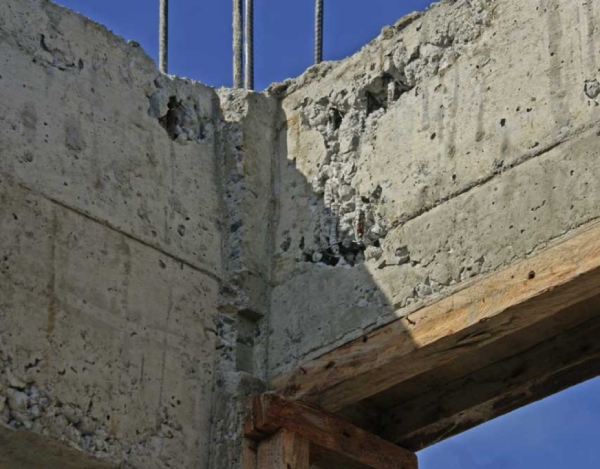
Honeycombs or rock pockets are areas of concrete where voids are left in the concrete due to failure of the cement paste or concrete to fill the spaces around coarse aggregate particles and reinforcing steel. These voids are spread over small areas locally and may be present either at one or two places or over the entire concrete surface or even within the member sometimes.
Where can we find Honeycomb in Concrete Structure?
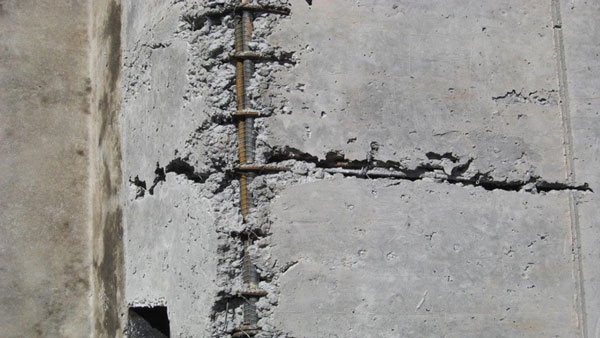
Honeycombs in the reinforced concrete structure are visible to naked eyes and can be seen once shuttering is removed. However, honeycombs inside the mass of concrete can only be identified by techniques like Ultrasonic Testing. Honeycombs in concrete are found in all types of elements like footings, walls, columns, beams, slabs etc. However, they are more prevalent in thin sections and also in members where there is huge congestion of reinforcement.
What Causes Honeycomb in Concrete?
We are hereby mentioning some major reasons which are responsible for Honeycomb in concrete:
01. Honeycomb in Concrete Due to Poor Workability of Concrete
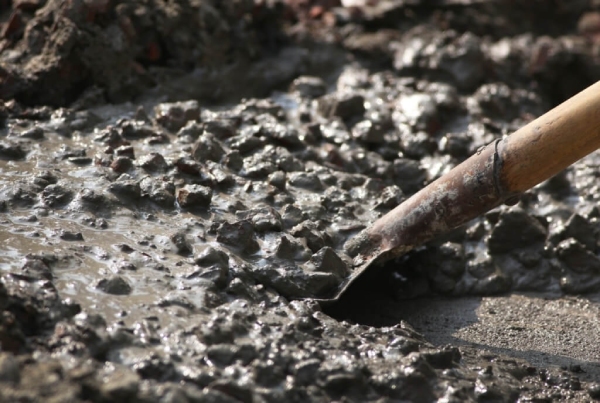
As per definition given by Indian Standard Code – IS 6461- 7[349], Workability is the property of freshly mixed concrete or mortar which determines the ease and homogeneity with which it can be mixed, placed, finished and compacted. Workability of concrete is the fundamental property of fresh concrete. It is also related to the type of construction, method of placing concrete, compacting and finishing.
The workability of concrete contains two aspects, consistency and cohesiveness. Due to the different requirements and characteristics of two aspects, the influence of a factor on workability may be opposite. In general, the water content, the cement content, the aggregate grading, the other physical characteristics and admixtures are some of the factors that affect the workability of concrete. However, the water cement ratio, and aggregate cement ratio play a major role in influencing the workability of concrete.
Workability can be poor because of reasons like – low water content, high temperature and the inappropriate ratio of fine-to-coarse aggregates.
Concrete with poor workability is not cohesive and consistent, and thus, will result in either segregated concrete or concrete with honeycombs i.e. voids, resulting in leakage and low strength. Therefore, it requires a lot of effort in handling, placing and compaction, in particular.
02. Honeycomb Defect in Concrete Due to Defective Formwork
When joints of formwork are loose or the formwork is not leak-proof, there can be leakage of grout through the joints or holes. As a result, honeycomb in concrete occurs as the grout will flow out during compaction.
03. Improper Compaction of Concrete

Concrete compaction is the process of removing air from the freshly poured concrete and packing the aggregate particles together to increase the density of the concrete. Different methods are implemented for compacting the concrete. i.e. hand compaction, compaction by vibration etc. When compaction is done by vibration method, over vibration will result in to the segregated concrete. Similarly, under vibrated concrete will also enable formation of honeycombs in it.
Gharpedia has written an article on the compaction of concrete for your in-depth study. Click on this link to know more –
04. Honeycombing in Concrete Due to Improper Rebar Placement or Poor Detailing
If reinforcement bars are placed too close to each other or too close to formwork then either because of poor detailing or inferior and inefficient workmanship, it will entrap the larger pieces of aggregates. Besides, it creates hindrance in concrete flow and vibration, which will lead to concrete honeycombing.
05. Concrete Honeycombing Due to Segregation of Concrete
Segregation can be defined as the separation of the constituent materials of fresh concrete. If a sample of concrete tends to separate, such concrete is not only weak, but it will further lead to voids or honeycombs in it.
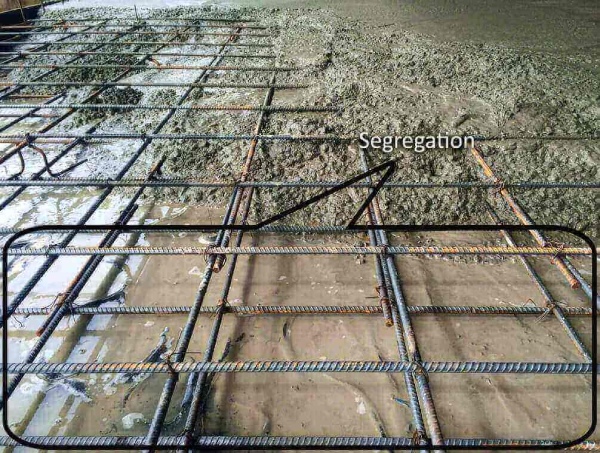
If you want to know in entirety about the segregation of concrete, including their types and causes, please click on the following link –
Effects of Honeycombing in Concrete
Due to the honeycomb defect in concrete, the water and air keeps seeping inside the concrete. As a final result, reinforced concrete structure loses its strength and ultimately its load-bearing capacity. Because of the presence of air and water, the corrosion sets in inviting a major problem. Further, the ingress of co2 will lead to carbonation. This will lead to loss of durability i.e.less life or frequent repairs.
The voids are left in concrete because of concrete honeycombing. According to the research paper “Effects of Parameters of Air-Avid Structure on the Salt-Frost Durability of Hardened Concrete” by ‘Hui Zhang et al’[350], the compressive strength of Mix Designs depends on the two factors. i.e., effective air voids content and gradation fineness modulus. It is because of the voids present in the concrete which lead to decrease in the compressive strength of concrete. 1% voids in concrete, reduces compressive strength of concrete by 5%.
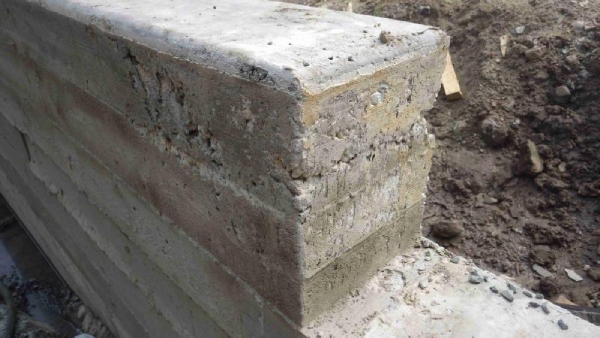
Practices to minimize the Occurrence of Concrete Honeycombing
According to Cement and Concrete Association of Australia, the following preventative measures are recommended to avert honeycombing in concrete:
01. Ensure that the mix contains sufficient fine aggregates to fill the voids between the coarse aggregates. Use of large size aggregate increases the risk of concrete honeycombing.
02. Make sure that the fresh concrete mix has appropriate and suitable workability for the situation including the section in which it is to be placed. Ensure optimum water cement ratio, aggregate cement ratio accordingly. Also use uniformly graded aggregates.
03. Use the proper method of concrete compaction and ensure the concrete is fully compacted. Also use the appropriate placing methods and minimize the risk of segregation. Do not place concrete from more than 1.00 m height, particularly in walls and column.
04. Provide sufficient thickness of concrete cover to reinforcement. Ensure that the reinforcement layout and section shape will allow the concrete to flow around the reinforcement. Allow adequate space between any two bars as per codal provisions.
05. Check that the formwork is well braced, rigid and the joints are watertight. Verify that the formwork is free from perforation and confirm whether it is properly sealed or not. Also, provide sufficient supports to formwork, particularly at all the joints in formwork. Do not leave any holes or gaps in the formwork.
Is it Essential to Repair a Honeycombed Concrete?
The simple answer to this question is Yes. Concrete honeycombing can cause severe problems if it spreads over a large area, exposing steel bars and penetrating 5 cm or more into the concrete. You cannot leave it as it is or unattended. The affected area must be repaired as soon as possible. It distorts not only the appearance of structural members but also reduces structural strength and durability i.e. reduces life. Let us see how to repair honeycomb defect in concrete.
How Can We Repair Honeycombed Concrete
Any repair to honeycomb concrete will never give the strength which the well compacted concrete normally gives. It is therefore recommended to take precautions as outlined to avoid them. However, if honeycombing occurs, it can be repaired using the following techniques.
Honeycomb concrete repair techniques include removing of loose material, cleaning the affected area, applying appropriate repair materials, grouting wherever needed and curing. Let us look at the method for concrete honeycomb repair step by step.
01. First and the foremost thing, is to determine the extent and depth of the honeycombed area by visual inspection or by using a non-destructive test i.e. Impact-echo test. You can also strike hammer of blows and inspect. If it sounds hollow, it indicates honeycombing in that particular region. The area and depth of the affected region needs to be assessed correctly.
02. Before you undertake it for repairing, remove all the loose material and dust on that area by using a hammer or wire brush. During this stage of concrete honeycomb repair, prevent the application of large forces such as electrical chippers to avoid concrete damage around the honeycomb area.
03. Wet the concrete surface before repair or replacement.
04. If the honeycomb area is small in quantum and the quality of the concrete cover can protect the reinforcement, then it can be repaired by patching with mortar of similar color to the base concrete. While patching, you can use high strength, non-shrink concrete grout mix with an epoxy binder. The Grout strength should be minimum and preferably equal or exceed specified concrete strength. It is also recommended to use polymer mortar for repairs.
05. Honeycombing in concrete can be repaired with Portland cement mortar if less than 24 hours have elapsed since the formwork was removed and not more than 72 hours have passed since concrete placement. At this time this defect is considered as a minor defect. If repair is delayed longer than this, or if the rock pocket is extensive, the defective concrete must be removed and replaced with new concrete, with higher strength and lower ability applying proper bonding agent.
06. If the honeycomb covers a substantial area or extensive portion and has penetrated down to the reinforcement or deeper, then it is necessary to cut out the defective concrete and replace it with new concrete along with a coating of an appropriate bonding agent.
07. If Voids are spread over and deep inside, then you really need to do grouting. Place formwork if necessary and pour the grout. If formwork is not used then apply suitable repair material like nonshrinkage concrete grout, high strength concrete grout etc. by grouting.
Grouting is a process of filling the cracks or voids under pressure in concrete or masonry structural members. In this technique, the grout mix which consists of a mixture of sand, cement, and water is applied under pressure preferably with grout pump of 5 kg/cm2 pressure to fill the cracks and voids in the structure. Pressure grouting will fill the voids with materials of same strength.
According to ‘Edward G. Nawy’[348] (Author: Concrete Construction Engineering Handbook), Do not use grout that contains calcium chloride or other materials containing chloride, because as per the research paper “Effects of Calcium Chloride on Portland Cements and Concretes” by ‘Paul Rapp’, The addition of calcium chloride will increase the strength in the first few days, but after some time, the strength will decrease, and chlorides also initiates corrosion.
08. The process should be carried on by filling a 15 mm thick layer gradually and repetitively if the depth of honeycombing is more than 5 cm. It is recommended to wait for 30 minutes before applying the next layer.
09. A qualified engineer must be consulted to check whether the load-bearing capacity of the member after repairs will be satisfactory or no. This becomes almost mandatory if the honeycomb was over a large area or an important element like a column.For further information regarding concrete honeycombing, its reasons and remedies, please do watch the online documentary by Civil Mentors – Engineering Simplified. (It is the team of professional engineers in United States that provides quality information).
Summing up, Generally, Reinforced concrete has been considered a durable structural material. Also, it can sustain and uphold with little maintenance for many decades. The versatility of concrete makes it the most popular structural material in various parts of the globe. However its limitations as a material, and several other factors like severe exposure conditions, poor design, poor detailing and poor construction practices are responsible for defects or damage in concrete. Out of those various types of defects, honeycomb defect in concrete is one such critical defect that needs immediate attention. Take the necessary precautions mentioned above time to minimize the occurrence of honeycomb in concrete.
Dear Readers, if you find this article informative, here’s the link of some more interesting articles for you. Please click on the links below –
Do’s & Don’ts While Concreting
Big Mistakes that must be Avoided in Formwork while Concreting
































